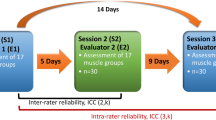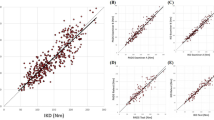Abstract
In rehabilitation medicine, muscle function is assessed during the physical examination of the patient. Although a simple hand-held instrument improves the assessment of static strength, it is rarely used in clinical practice, where dynamic measurements are preferred. A computer-assisted hand-held dynamometer (CAHNDY) has been developed that enables the clinician to measure dynamic muscle function in a standardised manner, using simple (i.e. portable and low-cost) apparatus. The CAHNDY comprises a force transducer and a movement transducer interfaced to a personal computer. In the study dynamic measurement protocols are used, based on a biomechanical analysis of daily activities. In this way, iso-functional profiles can be established, describing the kinematics of muscle function in its functional context. Using the iso-functional profiles as a basis for standardisation, the double feedback algorithm of the CAHNDY assists the tester in meeting this standard, during maximal muscle function testing. In a multi-centre trial, the CAHNDY is evaluated by physical therapists for knee extensor and flexor function. The CAHNDY enables iso-functional dynamic muscle function testing, although application is limited by the maximal strength of the tester. It is concluded that the CAHNDY is suitable for use in rehabilitation medicine.
Similar content being viewed by others
References
Aitkens, S., Lord, J., Bernauer, E., Fowler, W. M., Lieberman, J. S., andBerck, P. (1989): ‘Relationship of manual muscle testing to objective strength measurements’,Muscle Nerve,12, pp. 173–177
Amundsen, L. R. (Ed.) (1990): ‘Muscle strength tesing. Instrumented and non-instrumented systems’ (Churchill Livingstone, New York, USA)
Bäckman, E. (1988): ‘Methods of measurement of muscle function. Methodological aspects, reference values for children, and clinical applications’,Scand. J. Rehabil. Med.,20,Suppl. 20
Baratta, R., Solomonov, M., Zhou, B. H., Letson, D., Chuinard, R., andD'Abrosia, R. (1988): ‘Muscular coactivation. The rolw of the antagonist musculature in maintaining knee stability’,Am. J. Sports Med.,16, (2), pp. 113–122
Beasley, W. C. (1956): ‘Influence of method on estimates of normal knee extensor force among normal and postpolio children’,Phys. Ther. Rev.,36, pp. 21–41
Bobbert, M. F., andHarlaar, J. (1992): ‘Evaluation of moment-angle curves in isokinetic knee-extension’,Med. Sci. Sports Exerc.,25, (2), pp. 251–259
Bohannon, R. W. (1986): ‘Manual muscle test scores and dynamometer test scores of knee extension strength’,Arch. Phys. Med. Rehabil.,66, pp. 390–392
Cyriax, J. (1978): ‘Textbook of orthopaedic medicine. Vol. 1, Diagnosis of soft tissue lesions’ (Bailliere Tindall, London, UK) 7th edn.
Daniels, L., andWortingham, C. (1972): ‘Muscle testing: techniques of manual examination’, (WB Saunders Company, London, UK) 3rd edn.
Doorenbosch, C. A. M., Harlaar, J., Roebroeck, M. E., andLankhorst, G. J. (1994): ‘Two strategies of transferring from sit-to-stand; the activation of biarticular muscles’,J. Biomech.,27, (11), pp. 1299–1307
Edwards, R. H. T., andMcDonnel, M. (1974): ‘Hand-held dynamometer for evaluating voluntary muscle function’,Lancet,ii, pp. 757–758
Fillyaw, M. J., Tandan, R., andBradley, W. G. (1987): ‘Serial evaluation of neuromuscular function in management of chronic inflammatory demyelinating polyneuropathy’,Phys. Ther.,67, pp. 1708–1711
Gülch, R. W. (1994): ‘Force-velocity relations in human skeleton muscle’,Int. J. Sports Med.,15,Suppl. 1, pp. s2-s10
Harlaar, J., Roebroeck, M. E., andLankhorst, G. J. (1993): ‘Quantitative assessment of joint function in clinical practice—a biomechanical based rationale for interpretation’in Metral, S. (Ed.): Abstracts of the XIVth Congress of the International Society of Biomechanics, Paris, France, pp. 552–553
Hislop, H. J., andPerrine, J. J. (1967): ‘The isokinetic concept of exercise’,Phys. Ther.,47, pp. 114–117
Hyde, S. A., Scott, O. M., andGoddard, C. (1983): ‘The myometer: the development of a clinical tool’,Physiotherapy,69, pp. 424–427
Kannus, P. (1994): ‘Isokinetic evaluation of muscular performance: Implications for muscle testing and rehabilitation’,Int. J. Sports Med.,15,Suppl. 1, pp. s11-s18
Kendall, H. O., Kendall, F. P., andWadsworth, G. E. (1971): ‘Muscles testing and function’ (Williams and Wilkins Company, Baltimore, USA) 2nd edn.
Knapik, J. J., Wright, J. E., Mawdsley, R. H., andBraun, J. M. (1983): ‘Isokinetic, isometric and isotonic strength relationships’,Arch. Phys. Med. Rehabil.,64, pp. 77–80
Kramer, J., Nusca, D., Fowler, P., andWebster-Bogaert, S. (1993): ‘Knee flexor and extensor strength during concentric and eccentric muscle actions after anterior cruciate ligament reconstruction using the semitendinosus tendon and ligament augmentation device’,Am. J. Sports Med.,21 (2), pp. 285–291
Lamb, R. L. (1985): ‘Manual muscle testing’in Rothstein, J. M. (Ed.): ‘Measurement in physical therapy’ (Churchill Livingstone, New York, USA) pp. 47–56
Lankhorst, G. J., van de Stadt, R. J., andJ. K. Korst, (1985): ‘The relationships of functional capacity, pain, and isometric and isokinetic torque in osteoarthrosis of the knee’,Scand. J. Rehabil. Med.,17, pp. 167–172
Lovett, R. W. (1916): ‘The treatment of infantile paralysis’ (Blakiston's Son & Co., Philadelphia, USA)
Marino, M., Nicholas, J. A., Gleim, G. W., Rosenthal, P., andNicholas, S. J. (1982): ‘The efficacy of manual assessment of muscle strength using a new device’,Am. J. Sports Med.,10, pp. 360–364
Medical Research Council (1943): ‘Aids to the investigation of peripheral nerve injuries’. War Memorandum 7 (2nd edn.) (HMSO, London, UK)
Meijs, P. J. M., Roebroeck, M. E., andHarlaar, J. (1990): ‘Assessment of strength and range of motion about the knee’,Ned. T. Fysioth.,100, pp. 258–266 (in Dutch)
Nicholas, J. A., Sagega, A., Kraus, H., andWebb, J. N. (1978): ‘Factors influencing manual muscle tests in physical therapy’J. Bone Joint Surg.,60-A, pp. 186–190
Pai, Y.-C., andRogers, M. W. (1990): ‘Control of body mass transfer as a function of speed of ascent in sit-to-stand’,Med. Sci. Sports Exer.,22, pp. 378–384
Pearn, J. (1978): ‘Two early dynamometers: an history account of the earliest measurements to study human muscular strength’,J. Neurol. Sci.,37, pp. 127–134
Perrine, J. J., andEdgerton, V. R. (1978): ‘Muscle force-velocity and power-velocity relationships under isokinetic loading’,Med. Sci. Sports Exer.,10, pp. 159–166
Roebroeck, M. E. (1994): ‘Clinical assessment of muscle function with a computer-assisted handheld dynamometer. Ph.D. Thesis, Free University, Amsterdam, The Netherlands
Roebroeck, M. E., Harlaar, J., andLankhorst, G. J. (1993): ‘The application of generalizability theory to reliability assessment: an illustration using isometric force measurements’,Phys. Ther.,73, pp. 386–401
Roebroeck, M. E., Doorenbosch, C. A. M., Harlaar, J., Jacobs, R., andLankhorst, G. J. (1994): ‘Biomechanics and muscular activity during sit-to-stand transfer’,Clin. Biomech.,9, pp. 235–244
Rothstein, J. M. (Ed.) (1985): ‘Measurement in physical therapy’ (Churchill Livingstone, New York, USA)
Rothstein, J. M., Lamb, R. L., andMayhew, T. P. (1987): ‘Clinical uses of isokinetic measurements. Critical issues,Phys. Ther.,67 (12), pp. 1840–1844
Salter, N. (1955): ‘Methods of measurement of muscle and joint function’,J. Bone Joint Surg.,37-B (3), pp. 474–491
Scott, O. M., Hyde, S. A., Goddard, C., andDubowitz, V. (1982): ‘Quantification of muscle function in children: a prospective study in Duchenne muscular dystrophy’,Muscle Nerve,5, pp. 291–301
Snow, J. C., Coopers, J., Quanbury, A. O., andAnderson, J. E. (1993): ‘Antagonist cocontraction of knee flexors during constant velocity muscle shortening and lengthening’,J. Electromyogr. Kinesiol.,3, pp. 78–86
Stam, H. J., andBinkhorst, R. A. (1989): ‘Muscle strength impairment and disability in Guillain-Barre patients: a pilot study’,J. Rehabil. Sci.,2, pp. 108–110
Stam, H. J. (1990): ‘Dynamometry of the knee extensors: isometric and isokinetic testing in healthy subjects and patients’. PhD. Thesis, Erasmus University, Rotterdam, The Netherlands
Stuberg, W. A., andMetcalf, W. K. (1988): ‘Reliability of quantitative muscle testing in healthy children and in children with Duchenne muscular dystrophy using a hand-held dynamometer’,Phys. Ther.,68, pp. 977–982
van Ingen Schenau, G. J., Boots, G. J., De Groot, P. J. M., Snackers, R. J., andvan Woensel, W. W. L. M. (1992): ‘The constrained control of force and position in multi-joint movements’,Neurosci.,46, pp. 197–207
van der Ploeg, R. J. O., Oosterhuis, H. J. G. H., andReuvekamp, J. (1984): ‘Measuring muscle strength’,J. Neurol.,231, pp. 200–203
van der Ploeg, R. J. O., Fidler, V., andOosterhuis, H. J. G. H. (1991): ‘Hand-held myometry: reference values’,J. Neurol. Neurosurg. Psych.,54, pp. 244–247
van der Ploeg, R. J. O. (1992): ‘Hand-held dynamometry’, PhD Thesis, Rijksuniversiteit Groningen, Groningen, The Netherlands
van der Wees, Ph. J., Bobbert, M. F., andHarlaar, J. (1993): ‘Use of isokinetic equipment in the Netherlands: an inventory’,Geneeskunde en Sport,26, pp. 197–202 (in Dutch)
Vleeming, A., Winkel, D., andMeijer, O. G. (1984): ‘Weke delen aandoeningen van het bewegingsapparaat. Deel 1, Anatomie in Vivo’ (Bohn, Scheltoma & Holkoma, Utrecht, The Netherlands) (in Dutch) 4th edn.
Walla, D. J., Albricht, J. P., McAuley, E., Martin, R. K., Eldridge, V., andEl-Khoury, G. (1985): ‘Hamstring control and the unstable anterior cruciate ligament-deficient knee’,Am. J. Sports Med.,13(1), pp. 34–39.
Westers, B. M. (1982): ‘Factors influencing strength testing and exercise prescription’,Physiotherapy,68, pp. 42–44
Wikholm, J. B., andBohannon, R. W. (1991): ‘Hand-held dynamometer measurements: tester strength makes a difference’,J. Orthop. Sports Phys. Ther.,13, pp. 191–198
Wiles, C. M., andKarni, Y. (1983): ‘the measurement of muscle strength in patients with peripheral neuromuscular disorders’,J. Neurol. Neurosurg. Psych.,46, pp. 1006–1013
Author information
Authors and Affiliations
Corresponding author
Rights and permissions
About this article
Cite this article
Harlaar, J., Roebroeck, M.E. & Lankhorst, G.J. Computer-assisted hand-held dynamometer: low-cost instrument for muscle function assessment in rehabilitation medicine. Med. Biol. Eng. Comput. 34, 329–335 (1996). https://doi.org/10.1007/BF02519999
Received:
Accepted:
Issue Date:
DOI: https://doi.org/10.1007/BF02519999




